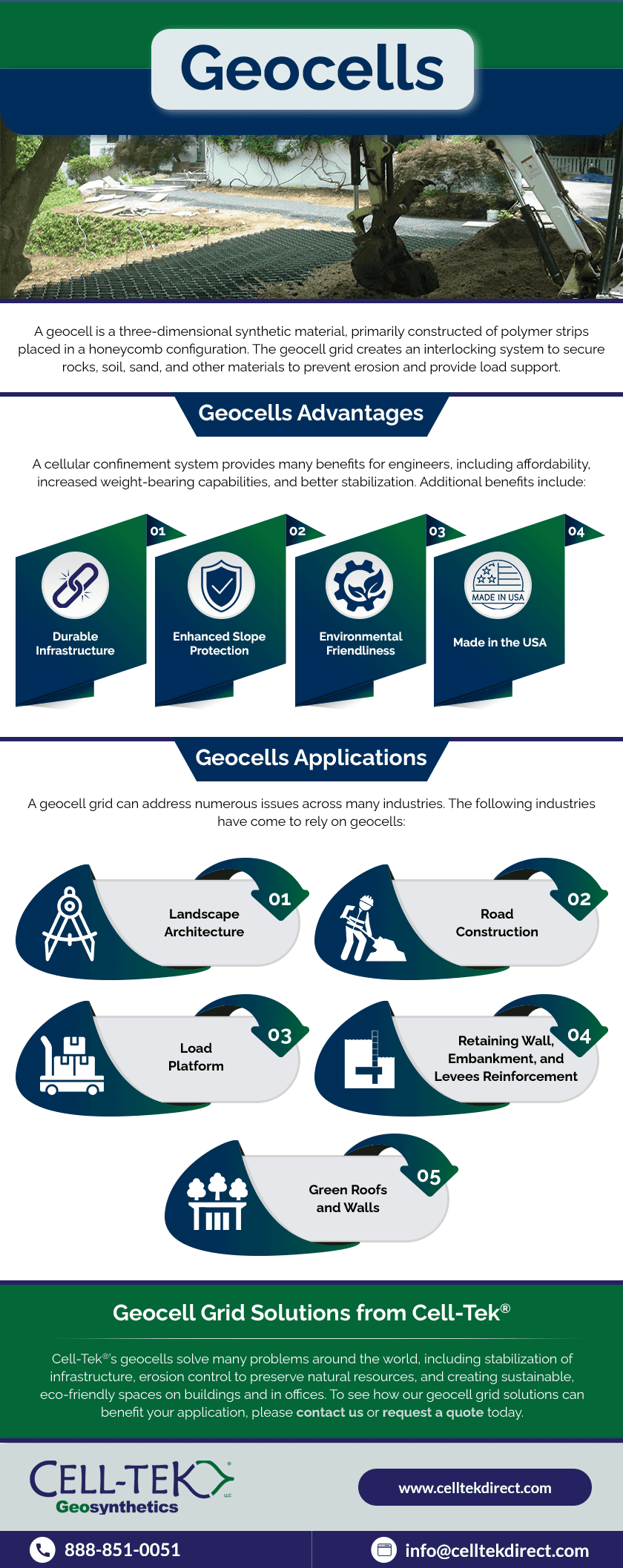Geocells
A geocell is a three-dimensional synthetic material, primarily constructed of polymer strips placed in a honeycomb configuration. The geocell grid creates an interlocking system to secure rocks, soil, sand, and other materials to prevent erosion and provide load support. Though first designed for military roads, they now serve a wide variety of foot and vehicular traffic applications. Geocells also see frequent usage in agriculture, landscape architecture, green roofing, paths, walkways, trails, golf courses, construction, and many others.
Cell-Tek is an industry leader in geocell solutions, as evidenced by our LSG and SlopeGrid products.
Geocells Advantages
Infrastructure development involves the engineering and development of the structures while ensuring that they don’t negatively impact natural resources. Soil stabilization and reinforcement are a big concern and potential risk to the ongoing stability of the roads, bridges, and footpaths.
A cellular confinement system provides many benefits for engineers, including affordability, increased weight-bearing capabilities, and better stabilization. Additional benefits include:
- Durable infrastructure. Geocells are heavily used in civil engineering for building roads and pavement because they provide a flexible base while holding the soil. Due to their superior load distribution capabilities, they prevent much of the stress cracking that otherwise occurs in paved roads.
- Enhanced slope protection. A geocell grid offers a more durable alternative to stone pitching or mulch mats, even on steep slopes. It prevents erosion without the need for expensive materials or skilled labor.
- Environmental friendliness. A cellular confinement system provides an eco-friendly way to build green slopes or retaining wall systems. The geocells can be filled with vegetation, concrete, or use locally sourced materials like soil or gravel without extensive quarrying. Using locally sourced materials increases the positive effects on the environment by decreasing your carbon footprint.
Types of Geocells
Geocells have changed the face of sustainable building initiatives, from stabilizing building foundations to preventing soil erosion in agricultural applications. They come in different types and specifications to solve varying issues with different types of soil.
- Perforated geocells have uniform holes in the walls of the cells to provide enhanced stress distribution and reduction of deformation.
- Non-perforated geocells have smooth, solid walls.
- Geonets, geomembranes, and prefabricated vertical drains see occasional use as application-specific alternatives to geocells.
Geocells Applications
A geocell grid can address numerous issues across many industries. The following industries have come to rely on geocells:
Landscape Architecture
In landscape architecture, protecting plants and soil from erosion involves the implementation of specialized solutions such as geocells. Geocell grids will decrease unwanted runoff or groundwater flow and stop the formation of erosion channels that threaten the landscape. Other benefits include protecting riverbeds and tree roots; stabilizing the ground, soil, and channel walls; and preventing erosion in greenbelts, slopes, and vegetation.
Road Construction
Almost 80% of the roads in the world are unpaved gravel access roads. These roads are often built on unstable soil, such as expansive clay, peat bogs, or sand. Without proper technology in place, these materials will crumble and threaten the safety, solidity, and longevity of the roadways. Geocells provide the stiffness and creep resistance needed to stabilize roads on soft soils. They prevent shrinking and cracking in clay, mitigate lateral dispersion and strain from sandy soils, and reinforce the subgrades in all soft soils.
Load Platform
Geocells provide an ideal means for creating semi-rigid platforms over poor soils and areas that have digging restrictions. These geocell grids increase the load capacity of grade slabs, foundation spread, and strip footings. Cellular confinement systems also reduce pavement sections in laydown areas, parking lots, and roadways.
Retaining Wall, Embankment, and Levees Reinforcement
Erosion is always a concern any time soil and vegetation require alteration. Geocells provide erosion protection for embankments and natural slopes. They also work well for securing water channels and water pond linings.
Green Roofs and Walls
Green spaces, such as rooftop flower and vegetable gardens, have become an increasingly popular trend in cities. Geocells make these spaces possible with their expandable honeycomb formation that holds soil and promotes structural integrity. Green walls are also popular for some homes and offices, also made possible with geocell grids.
Geocell Grid Solutions from Cell-Tek
Cell-Tek’s geocells solve many problems around the world, including stabilization of infrastructure, erosion control to preserve natural resources, and creating sustainable, eco-friendly spaces on buildings and in offices. To see how our geocell grid solutions can benefit your application, please contact us or request a quote today.


